This article addresses the prospects for true, locally procured meals for a national school feeding program, something that does not yet exist. We present a series of the most commonly available local Haitian foods together with street costs and nutritional analysis. The suggestion is that prepared food containing twice the calories and protein available in a 200-gram meal of rice, beans and vegetables (what is currently fed to children in the WFP/BND/MENFP local procurement pilot school feeding program) could be delivered to Haitian schools by local vendors for as little as ½ or less the cost of currently fed meals.
Snacks, Meals, Prices, and Nutritional Content for Proposed Locally Procured School Feeding Program in Haiti
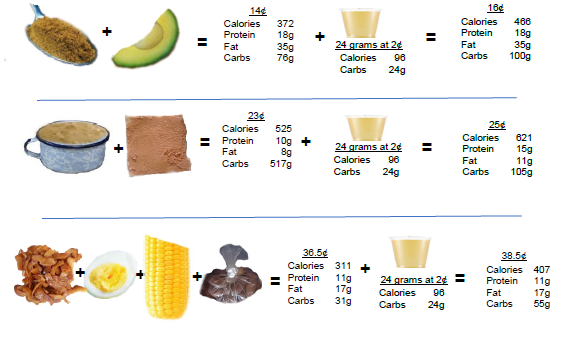
School Feeding in Haiti Background
In 2016, the Haitian Government Ministry of Education (MENFP), called for the National School Canteen Program (PNCS) to be transformed into a truly local feeding program based on the following three priorities:
- The provision of quality food services in schools through the inclusion of the private and voluntary sectors and the prioritization of a snack (breakfast) served before class opens each morning and, if funding allows, hot meal served after hours of study.
- Support for the local economy and the production of local food through quasi-exclusive food purchases from local producers.
- The development of the national capacities necessary for the proper management of school feeding programs, specifically requiring institutional reform and standardization of the National School Canteen Program (PNCS), coordination and management of contracts, and decentralization of program implementation through commitment of entities at the departmental and community levels, i.e. the PNCS will no longer intervene as a direct operator of school feeding. MENFP 2016 [i]
In brief, the program aims to, a) promote good nutrition among primary school children and b) promote national food sovereignty through improved local production.
If the Haitian national school feeding program is ever going to be truly local, if it is going to be sustainable, if it is going to promote domestic agricultural production—the vast bulk of which is peasant production–and if the Haitian government is ever going to assume full fiscal responsibility for the program, then arguably the program,
- a) must depend on local economies,
- b) must be low cost and
- c) must be administratively simple.
In effect, the national school feeding program should tap into the local internal marketing system and it should tap into the local industry of prepared food, thereby eliminating the need for high administrative costs associated with the current program and relieving school officials of the burden of the program. With this in mind, below we present a series of most easily procured local meals—foods that street merchants sell throughout Haiti– their prices and nutritional content.
(Note that all quantities are based on actual samples purchased and prices from surveys conducted with respondents in the department of Nippes, where WFP and MENFP piloted a Brazilian-funded, 2015 to 2017 local procurement school feeding program. The nutritional content analyses are only meant to be suggestive as they are based on resources available through rapid online searches and likely do not include full calorific content as the value of cooking oil tends to be underestimated–in what might be a strategy to maximize caloric intake for price, Haitians tend to saturate foods with cooking oil, see this article and this report).
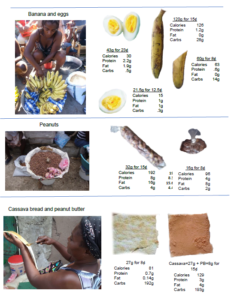
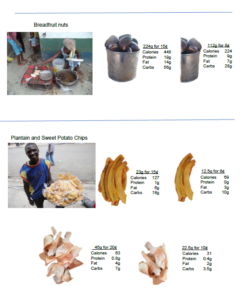
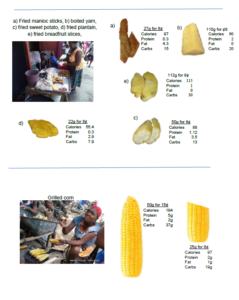
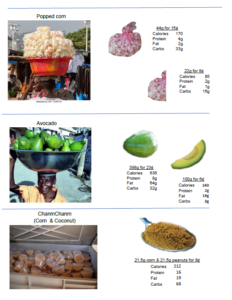
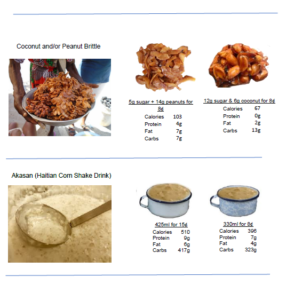
Rounding off the Meal with High Calorie and Low-Cost Juices
As with most Westerners, Haitians use a wide variety of fruits that they consume in the form of juice. However, they also make juices from vegetables, opening the opportunity to efficiently provide high-calorie with fresh produce in the form of a juice. While ‘nutritionally incorrect’ in developed countries, sugar is arguably the reason many Haitians have been able to survive on extremely low incomes. After edible oils at 7 calories per gram, sugar has the most calories per gram of any food, 4. per gram. More importantly however, it is the lowest cost staples per calorie (1.5 US cents per 27 grams). The raw reality of poverty facing Haitian children and their need for calories first and formost. Moreover, during focus groups school directors claimed that parents would provide fruits free to schools. The juices can be an addition to any meal, typically drank after the solids are consumed—such as those listed in the previous section– or they can and are consumed with bread, something that is culturally appropriate and a commune breakfast strategy. In the case of local procurement school feeding, wheat bread can be replaced with cassava, or other candidates for the introduction of alternative bread products are breadfruit, millet. Moreover, juices are impregnated with sugar, something that together with edible oils is the most cost-effective source of calories and can thereby be used to assure that children get enough caloric intake while the other foods assure the consumption of vitamins and proteins.
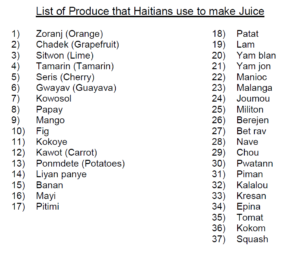
Comparative Costs of Local Foods and Meals Compared to Imported Meals and Foods
The significant point about the foods presented above is that they are, a) completely local in the sense that they are typical street foods sold throughout Haiti, b) the prices and quantities are known local prices on the street, c) the costs include preparation and delivery, i.e. vendors would/could provide these products to the schools. Thus, compare 2017 WFP and BND meals plus administrative and preparation costs for vegetables with rice and beans to similarly balanced local meals.
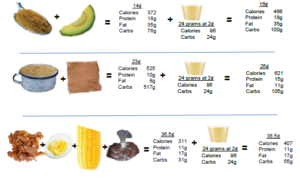
NOTES
[i] The list of priorities are taken from the, Ministère De L’éducation Nationale Et De La Formation Professionnelle (MENFP) Programme National De Canteen Scolaire (PNCS). Politique et strategie nationales d’alimentation scolaire (PSNAS)
La prestation de services alimentaires de qualité dans les écoles par l’inclusion du secteur privé et associatif et la priorisation du snack (petit déjeuner) servi avant l’ouverture des classes et, si les financements le permettent, du repas chaud servi après les heures d’étude.
Le soutien à l’économie locale et la production d’aliments locaux en exigeant que ces derniers entrent de façon quasi-exclusive dans le panier des aliments fournis dans les écoles.
Le développement des capacités nationales nécessaires à la bonne gestion des actions d’alimentation scolaire, nécessitant spécifiquement une réforme institutionnelle du Programme National de Canteen Scolaire (PNCS) autour de son rôle normatif, de coordination et de gestion de contrats et l’engagement des Collectivités territoriales et des communautés dans des modalités de mise en œuvre décentralisées. Le PNCS n’interviendra plus en tant qu’opérateur direct de l’alimentation scolaire.







